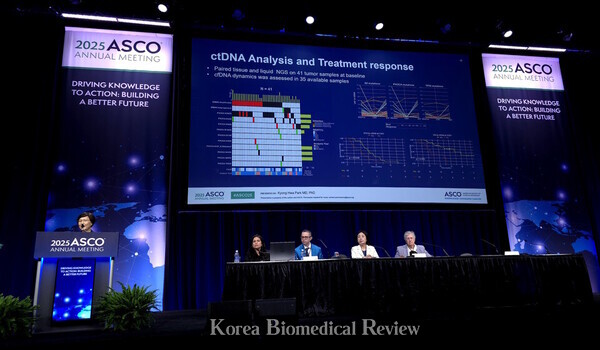
CHICAGO, Ill. - By Kim Yun-mi/ Korea Biomedical Review correspondent --HER2-positive metastatic breast cancer patients with PI3K pathway abnormalities are emerging as a new therapeutic target.
According to the results of a Korean investigator-led phase 2 clinical trial presented at the 2025 American Society of Clinical Oncology (ASCO) Annual Meeting (ASCO 2025) last Saturday (local time), the combination of trastuzumab biosimilar (Herzuma in trademark name) and PI3K/mTOR dual inhibitor gedatolisib showed significant antitumor effects in HER2-positive metastatic breast cancer patients with genetic abnormalities in the PI3K-AKT-mTOR pathway.
The study was an investigator-initiated clinical trial led by the K-MASTER Project and the Korean Cancer Study Group. Professor Park Kyong-hwa Park of the Department of Hematology-Oncology at Korea University Anam Hospital presented it.
“Global data suggests that the rate of PIK3CA mutations in advanced breast cancer patients is about 30-40 percent, but in Korean patients, the rate is reported to be higher at about 40 percent,” Professor Park said. “In particular, the rate tends to be higher in HER2-positive and hormone receptor-positive patients.”
The prognosis for patients with HER2-positive metastatic breast cancer has improved significantly over the past two decades with the development of HER2-targeted antitumor drugs such as trastuzumab, pertuzumab, T-DM1 (Kadcyla in trademark name, and T-DXd (Enhertu in trademark name). However, resistance eventually develops despite these therapies, and the need for new therapeutic targets and strategies has been steadily raised.
In particular, the PI3K-AKT-mTOR signaling pathway is a sub-pathway of HER2 signaling, and pathway abnormalities, such as “PIK3CA mutation”' and “PTEN defect,” have been reported to be associated with resistance to HER2-targeted therapy. Therefore, combination therapies that target both HER2 and PI3K pathway abnormalities are gaining attention as a strategy to overcome resistance.
“In clinical practice, we see patients who do not respond well to conventional therapies and progress rapidly, and when we perform NGS (next-generation sequencing) on these patients, we find that they have a common PIK3CA mutation,” Professor Park said. “We believe that a new target for this group of patients is needed.”
Based on this scientific background, the study was designed to evaluate the antitumor activity of the trastuzumab biosimilar in combination with gedatolisib in HER2-positive patients with PI3K pathway abnormalities, including PIK3CA mutations or PTEN deletions who had failed two or more HER2-targeted therapies.
The initial target number of patients was 62, but the study was terminated early in the final 44 patients due to drug supply issues with gedatolisib. The median age of patients was 59 years, and the median number of prior therapies was four. Regarding genetic abnormalities, 26 patients reported PIK3CA kinase domain mutations, 11 PIK3CA helical domain mutations, one amplification, two PTEN deletions, and four other mutations.
Of the 44 analyzable patients, two (4.5 percent) had a complete response (CR), and 17 (38.6 percent) had a partial response (PR), resulting in an objective response rate (ORR) of 43.2 percent and a disease control rate (DCR) of 86.4 percent.
The study also reported a median progression-free survival (mPFS) of six months and a median overall survival (mOS) of 24.7 months during a median follow-up of 32.05 months.
“We initially expected an ORR of about 25 percent, but the results exceeded our expectations with an ORR of over 43 percent,” Dr. Park said. “These results demonstrate that the PI3K pathway may be a novel target for patients with no further available targeted therapies after prior HER2-targeted therapy.”
In the safety evaluation, treatment-related adverse events (TRAEs) were primarily reported as oral mucositis (32.3 percent; 4.1 percent grade ≥3), skin reactions (14.1 percent; 1.8 percent grade ≥3), and hyperglycemia (6.8 percent; 0.5 percent grade ≥3). No serious adverse events related to the study drug were reported.

“Gedatolisib's mechanism of action is that it simultaneously inhibits not only PI3K but also mTOR, which is a major advantage,” Professor Park said. “Generally, inhibiting the PI3K pathway leads to an increase in blood glucose due to a class effect, but gedatolisib does not cause blood glucose to spike as much, so the incidence of hyperglycemia is low.”
She emphasized that the incidence of grade 3 or higher hyperglycemia in this study was as low as 0.5 percent, indicating a manageable toxicity profile, especially compared with other PI3K inhibitors.
Interestingly, some of the patients in this study did not benefit as much from the combination as they did from subsequent treatment with Enhertu, Park noted, suggesting that conventional HER2-targeted therapies or ADCs alone may not be sufficient in patients with PI3K mutations.
“Going forward, it will be important to recognize strong drivers, including PIK3CA mutations, in HER2-positive patients from the time of diagnosis and to develop a robust combination strategy that includes a PI3K inhibitor from the outset, which may lead to longer survival for some patients,” Professor Park stressed.
Related articles
- [ASCO 2025] Anticancer giant AZ expands its therapeutic armamentarium with Camizestrant-Imfinzi
- [ASCO 2025] Enhertu shows prolonged survival in 2nd-line treatment of gastric cancer
- [ASCO 2025] Trodelvy could emerge as standard of care for triple-negative breast cancer
- [ASCO 2025] Why can’t Korea also do it? KDDF head Park says
- [ASCO 2025] What is Hanmi's next-gen onocology development strategy?

